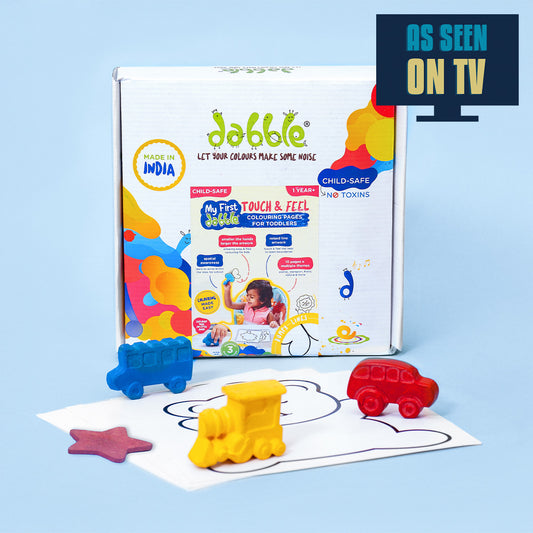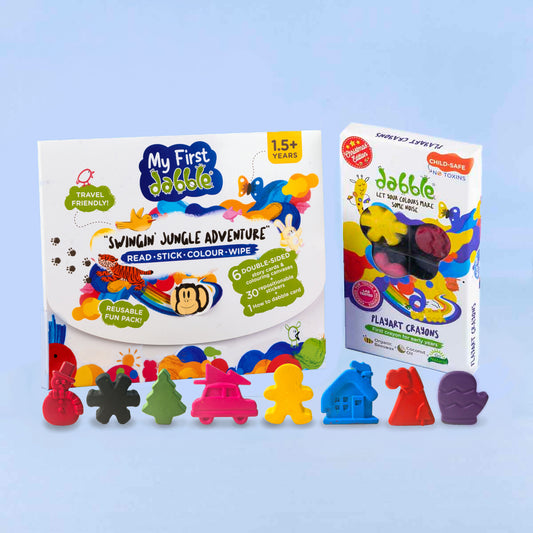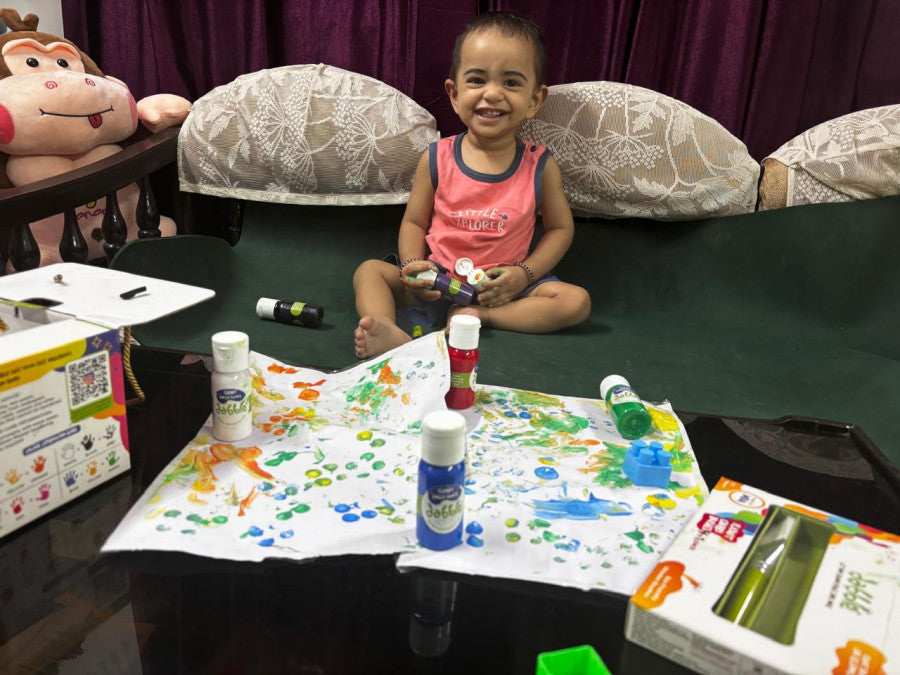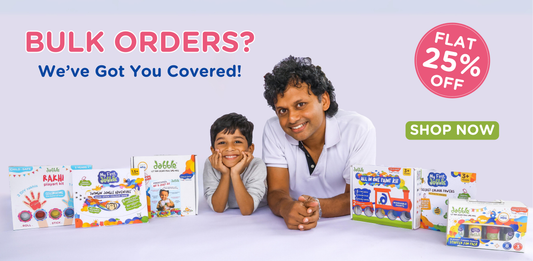Sensory activities are the best way to recognise things better and explore their texture and feel. Touch plays an important role in early ages. Children at early stages tend to recognise things by sound, smell and senses. Introducing colour and art at an early age causes significant changes in their overall development.
Sensory activities are essential for the children for their cognitive, emotional and physical growth. It helps in increasing fine motor skills and gross motor skills, hand and eye coordination, developing tactile awareness and understanding about textures.
Colours are one of the best sensory activities for early brain development. Kids love to play and explore with colours.
Allow kids to practice finger painting freely to explore colours and enhance their sensory activities.
How does kids' Finger painting help in the early stages?
Finger painting plays an important role in cognitive development, emotional development and physical development. It helps stimulate the left and right hemispheres of the brain, which promotes creativity and problem-solving skills as well.
Cognitive Development - Finger painting helps in fine motor skills, hand-eye coordination and overall dexterity. Children love to experiment with Paints, learn the combinations of colours and textures and encourage problem-solving and risk-taking.
Emotional Development - Colour art helps children to regulate their emotions. Through colour, children can express their hidden feelings as well. Even art and colour are also used in therapies for children as it has significant development.
I remember once my 6-year-old niece was sick and not able to go to school and meet her friends. She was sad and did not talk to anyone. We allowed her to finger paint freely. She was completely lost in painting freely. After some time, she started humming, which she usually does while playing. And it worked like magic. It instantly changed her feelings. She was smiling, and most importantly, she had some food happily. Art helps us to heal and reduce stress levels.
Physical development - It improves hand-eye coordination and strengthens grips and overall dexterity.
Finger painting encourages children to express and manage their emotions. Creating art enhances self-confidence and self-esteem. Finger painting helps in calming and soothing the emotions. Children create their small imaginary world with colour and explore new ideas.
Art activities like painting, colouring or drawing help in developing hand-eye coordination and dexterity.
I had a student who was 7 years old and had difficulty in writing. He was not able to hold the pencil properly. I introduced him to colours and he loved to scribble, finger paint and started painting with brushes as well. It gradually helped him to hold a pen and pencil, strengthening his hand-eye coordination.
Colour plays a vital role in early childhood and helps throughout life.
How do we introduce colour at an early stage?
It is very important to use the right colour at an early stage.
Always check on chemical-free, toxic-free and skin-friendly colours to enjoy their colourful journey.
Make sure to have a patch test. Introduce colours to kids in a funful way.
Why Dabble?
Go for Dabble Colours, made with natural ingredients these colours are toxin-free and skin-friendly
● Dabble products have natural, child-friendly ingredients.
● Always a safe colour for kids.
● Easy to clean from hands and floor.
● Enjoy mess-free painting.
● Dabble Paints for Kids makes finger painting for kids easy and safe and also brings development with a lot of happiness.
● Dabble paint brushes are designed child-friendly with soft wooden material which helps them to make a firm grip.
Finger painting Ideas for kids
There are plenty of amazing ideas to keep kids busy in a healthy way with colour which helps them in cognitive development, emotional development and physical development.
● Always make the activities interesting to kids.
● Allow kids to make their creative art with their colourful hands.
● Put the date on the back and laminate their creativity. It’s always a wonderful feeling when we look back on our little ones starting a creative journey with colours.
● Try using different props to stamp colours, and try mixing and making different shades.
● Share kid's handmade cards with their friends and family to encourage them to explore their creativity.
● Use different props or textures to explore more shapes or designs with colours.
● We can also use nature to paint like to paint with flowers or leaves.
Use Age-Specific Canvas painting for kids like-
Toddlers (2-3 years): Use large, soft brushes like Dabble painting brushes for a nice grip or they can finger paint as well and focus on exploring colours and textures.
Preschoolers (4-5 years): Introduce simple painting techniques, such as stamping or dripping (allow the paint to drip and form unique patterns)
School-age children (6-12 years): Encourage more complex techniques, such as layering or blending colours.
Wet-on-wet painting techniques
The wet-on-wet technique is a very interesting technique to introduce to kids where they can explore more creative ways to play with colours. It is a painting form that involves applying fresh paint onto a wet surface, allowing the colours to blend effortlessly and create soft, dreamy effects. This activity allows to bring new smooth textures and colours while combining different colours.
Wet-on-wet painting inspires creativity, sensory exploration, and free expression. It helps children develop fine motor skills, hand-eye coordination, and an understanding of colour blending in a fun, hands-on way. Additionally, the soft, flowing effects create a calming and engaging art experience, keeping them involved in the process for hours.
Salt Sprinkling Techniques
Allow kids to finger paint freely and explore new textures and designs. Ask them to sprinkle some salt on the colours before they dry. It will give different shades and designs to their art. Also, it will add new additions to sensory activity. We can use different salts to get different designs like rock salt, black salt, pink salt or normal salt.
Salt Sprinkling techniques help kids to learn simple science experiments that create new outcomes by adding salt to wet painting and giving new designs after it dries.
These techniques help them to enhance their creativity, confidence and self-esteem.
Finger Painting plays a very important role in kids' lives to express their hidden emotions. Art gives a safe space to an outlet for expressing emotions. Art also allows healing and self-connecting.
Finger painting is a great way to engage kids creatively. Let them dabble in their imaginary world with colours and create their masterpieces. Encourage them by giving constructive feedback. Finger painting encourages neuroplasticity, the brain’s ability to adapt to changes. Ensure the finger painting is enjoyable and creative for the toddlers. Colours play an important role in a child’s development, and they grow and learn with experiments. Ensure to introduce the children to the best colours and related products to keep their safety first in their growth.
Let children Happy Dabble their creativity.
Contributed By - Archana Nair, Child psychologist with a specialization in play therapy







